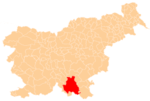Podlesje
| Podlesje Verdreng, Ferdreng (until 1955) | |
|---|---|
_location_map.svg.png) Podlesje Location in Slovenia | |
| Coordinates: 45°32′13.33″N 14°57′33.8″E / 45.5370361°N 14.959389°ECoordinates: 45°32′13.33″N 14°57′33.8″E / 45.5370361°N 14.959389°E | |
| Country |
|
| Traditional region | Lower Carniola |
| Statistical region | Southeast Slovenia |
| Municipality | Kočevje |
| Area | |
| • Total | 15.34 km2 (5.92 sq mi) |
| Elevation | 510.9 m (1,676.2 ft) |
| [1] | |
Podlesje (pronounced [pɔˈdleːsjɛ]; German: Verdreng[2][3]) is an abandoned settlement in the Municipality of Kočevje in southern Slovenia. It was a village inhabited by Gottschee Germans. During the Second World War its original population was expelled. The area is part of the traditional region of Lower Carniola and is now included in the Southeast Slovenia Statistical Region.[4]
Name
The name of the settlement was changed from Verdreng (identical to the German name Verdreng), or the Slovenianized form Ferdreng,[5] to Podlesje in 1955. The name was changed on the basis of the 1948 Law on Names of Settlements and Designations of Squares, Streets, and Buildings as part of efforts by Slovenia’s postwar communist government to remove German elements from toponyms.[6][7]
Church
The local church, dedicated to John the Baptist, was a Baroque church built in the 18th century on the site of an earlier church. It was demolished after 1952. A similar fate awaited the early 17th-century chapel dedicated to the Virgin Mary on Mount Verdreng (Verdrenška gora; also known as Mount Verderb, Verderbška gora[8]) north of the village, demolished between 1952 and 1955.[9][10] The hill itself was known as Virgin's Mount (Dekličina gora) before the war and is occasionally still labeled as such.[11] It was renamed after the war to remove its religious associations.[12]
History
During the Second World War, the village was burned by Italian forces in August 1942.[5]
After the Second World War, Slovenia's postwar communist authorities set up a forced labor camp for female political prisoners at Podlesje.[13][14][15][16][17] Internees were sentenced to perform "socially useful work" at the concentration camp. In 1949 about 600 women were imprisoned at the camp[12] under very poor hygiene conditions.[18] Eventually the camp was closed and the prisoners were transferred to the concentration camp at the castle in Škofja Loka, where they were gradually released.[19]
Together with Zgornji Pokštajn, Spodnji Pokštajn, and Lapinje, it was merged into the settlement of Podlesje in 1955.[20]
References
- ↑ Statistical Office of the Republic of Slovenia
- ↑ Leksikon občin kraljestev in dežel zastopanih v državnem zboru, vol. 6: Kranjsko. 1906. Vienna: C. Kr. Dvorna in Državna Tiskarna, p. 38.
- ↑ Ferenc, Mitja. 2007. Nekdanji nemški jezikovni otok na kočevskem. Kočevje: Pokrajinski muzej, p. 4.
- ↑ Kočevje municipal site
- ↑ 5.0 5.1 Savnik, Roman, ed. 1971. Krajevni leksikon Slovenije, vol. 2. Ljubljana: Državna založba Slovenije. p. 236–237.
- ↑ Spremembe naselij 1948–95. 1996. Database. Ljubljana: Geografski inštitut ZRC SAZU, DZS.
- ↑ Urbanc, Mimi & Matej Gabrovec. 2005. Krajevna imena: poligon za dokazovanje moči in odraz lokalne identitete. Geografski vestnik 77(2): 25–43.
- ↑ Mount Verderb at Geopedia (Slovene)
- ↑ Slovenian Ministry of Culture register of national heritage reference numbers ešd 2750 & 2751
- ↑ Verdreng (Podlesje) (Slovene) (German)
- ↑ Virgin's Mount at Geopedia (Slovene)
- ↑ 12.0 12.1 Žajdela, Ivo. 1991. Komunistični zločini na Slovenskem. Ljubljana: ČZP Novo jutro, p. 117.
- ↑ Žajdela, Ivo. 1990. "Gotenica - velika prevara?" Tribuna 11: 14–15.
- ↑ Mikola, Milko. 2006. Dokumenti in pričevanja o povojnij delovnih taboriščih v Sloveniji. Ljubljana: Ministrstvo za pravosodje Republike Slovenije, p. 114.
- ↑ Maša za bivše taboriščnice in taboriščnike (Mass for Former Camp Inmates) (Slovene)
- ↑ Program spominskih slovesnosti, romanj in komemoracij v letu 2011 (Schedule of Memorial Ceremonies, Pilgrimages, and other Commemorations in 2011), Item 10
- ↑ Mrvič, Irena. 1999. "Taborišče." Enciklopedija Slovenije, vol. 13 (Š–T), pp. 177–179. Ljubljana: Mladinska knjiga, p. 179.
- ↑ Gabrič, Aleš, Polona Kekec, & Brigita Rajšter. 2000. Odvetnica in pisateljica Ljuba Prenner: pogumna, da bi je bila drugačna. Ljubljana: Nova revija, p. 165.
- ↑ Žajdela, Ivo. 1991. Komunistični zločini na Slovenskem. Ljubljana: ČZP Novo jutro, p. 123.
- ↑ "Preimovanje, dopolnitve in popravki nekaterih krajevnih imen." 1955. Dolenjski list 8(25) (1 July): 4. (Slovene)
